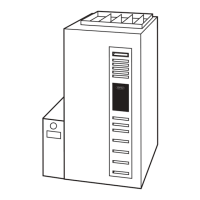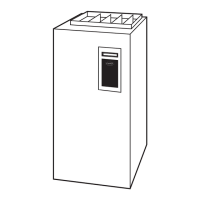heat (R-W/W1) is terminated, the blower remains operating at
low-heat speed for selected blower off delay before resuming
continuous fan speed.
3. Operating with continuous fan (R-G) and call for cooling
(R-Y/Y2) is received—See Cooling Mode section. After call
for cooling (R-Y/Y2) is terminated, the blower remains
operating at cooling speed for 90 sec before resuming con-
tinuous fan speed.
Step 8—Component Test
All components are functionally operated except gas valve with
component test feature.
This feature helps diagnose a system problem in case of a
component failure.
NOTE: Setup switch SW-1 MUST be in OFF position or Fault
Code 22 (setup error) will occur.
NOTE: NO thermostat signal may be present at control center,
and all blower time delay off periods must be completed.
To initiate component test feature, proceed with the following:
1. Leave 115-v power to furnace turned on.
2. Remove main furnace door.
3. Remove blower access panel.
4. Move setup switch SW-6 to ON position.
5. Manually close blower access panel door switch. Use a piece
of tape to hold switch closed.
Blower access panel door switch opens 115-v power to
control center. No component operation can occur. Caution
must be taken when manually closing this switch for service
purposes. Failure to follow this warning could result in
personal injury or death.
When items 1-5 have been completed, the following will occur:
1. The control center goes through a brief self-test. This self-test
takes approximately 2 sec to complete. After door switch is
closed, red (microprocessor) LED briefly comes on. Then
green LED comes on for 1 sec, followed by 1 sec where both
green and yellow LEDs are on. During this time, the micro-
processor is checking itself.
2. Inducer motor operates for 20 sec at low speed, operates for 20
sec at high speed, then turns off.
3. Hot surface ignitor is energized for 15 sec, then de-energized.
4. Main blower motor operates for 20 sec at low speed, operates
for 20 sec at high speed, then turns off.
5. After component operation test is completed, 1 or more fault
codes (11, 22, 41, or 42) will flash. See service label on back
of main furnace door for explanation of fault codes.
NOTE: To repeat component test, turn setup switch SW-6 to OFF
and then back to ON.
After component test, perform the following:
1. Release blower panel access door switch and turn setup switch
SW-6 to OFF position.
2. If applicable, replace blower access panel and check LED
status by removing plug in blower access panel.
3. Reinstall main furnace door if all LEDs are off, indicating
furnace is ready to operate when a signal from thermostat is
received.
Step 9—Bypass Humidifier Mode
When setup switch SW-3 BPH is in ON position, RPM calculated
for low heat is multiplied by 1.15 for all furnace model sizes. This
compensates for increased return-air temperature caused by by-
passed air supply.
Step 10—Dehumidification Mode
A dehumidification input is provided via a 1/4 in. male quick-
connect terminal labeled DEHUM located next to the transformer
secondary connections. When there is a dehumidify demand, the
DEHUM input is activated, which means 24 vac signal is removed
from the DEHUM input terminal. In other words, the DEHUM
input logic is reversed. the DEHUM input is turned ON when no
dehumidify demand exists and is turned OFF when demand exists.
This logic reversal has come about from historical use of a
standard humidistat to do dehumidification since the contacts open
on high humidity, thus removing the 24-v signal to initiate
dehumidification.
The DEHUM output on the thermidistat control or the humidistat
output, is connected directly to the DEHUM terminal on the
furnace control. In addition, the DE jumper located next to the
DEHUM terminal must be removed to enable the DEHUM input
(See Fig. 27 and 28). When a dehumidify demand exists, the
furnace control reduces the blower airflow by 21 percent to 315
CFM per ton during continuous fan or cooling operation.
This blower speed reduction compensates for high humidity
conditions during cooling operation on all furnace model sizes.
Reference Thermidistat™ Control Installation, Start-Up, and Op-
erating Instructions for further details.
Step 11—Zone Mode
When setup switch SW-5 MZ is in ON position, blower motor
control is the same as above except with the following exceptions:
1. While blower is operating in either low heat or continuous fan,
the coast down calibration is performed once a minute to
update blower RPM for zone damper position changes during
a given cycle unless the blower pulse width to blower motor
is greater than 60 percent. This prevents nuisance faults from
occurring when a high continuous fan CFM has been selected.
2. While blower is operating in either high heat or cooling,
blower pulse width to blower motor is frozen when blower
RPM is within 10 percent of calculated blower RPM for 5 sec.
START-UP PROCEDURES
Step 1—General
1. Furnace must have a 115-v power supply properly connected
and grounded.
NOTE: Proper polarity must be maintained for 115-v wiring. If
polarity is incorrect, control center fault indicator light flashes
rapidly and furnace does not operate.
2. Thermostat wire connections at terminals R, W/W1, G, and
Y/Y2 must be made at 24-v terminal block on control center.
3. Natural gas service pressure must not exceed 0.5 psig (14-in.
wc), but must be no less than 0.16 psig (4.5-in. wc).
4. Blower access panel must be in place to complete 24-v
electrical circuit to furnace.
36

